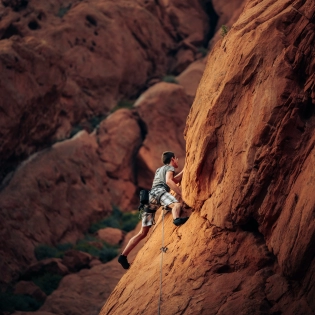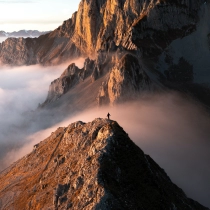







Climbers Point
It's generally not advised to soak your climbing shoes. Soaking can potentially damage the materials and affect the shoe's performance. Climbing shoes often have sensitive components like adhesives and non-water-resistant fabrics that may not react well to prolonged water exposure. Moreover, soaking can cause the shoes to stretch or lose their shape, which can impact their fit and precision while climbing. Therefore, it's best to avoid soaking your climbing shoes and opt for alternative cleaning methods, such as gently scrubbing them with a soft brush and mild soap, and allowing them to air dry.
As a climber, I wouldn't recommend putting your climbing shoes in the washing machine. The washing machine can be too harsh on the delicate materials and construction of climbing shoes, potentially damaging them. The agitation and high-speed spinning can cause excessive stress on the shoe's rubber, stitching, and overall structure. Additionally, the heat and detergents used in the washing machine can negatively affect the adhesive that holds the shoes together. Instead, it's best to clean your climbing shoes by hand. Gently scrub them using a soft brush, lukewarm water, and a mild soap or specialized climbing shoe cleaner. Afterward, allow them to air dry in a well-ventilated area away from direct heat sources. Taking these manual cleaning steps will help preserve the integrity and performance of your climbing shoes.
In the gym, the lifespan of climbing shoes can vary depending on factors such as frequency of use, climbing technique, and the type of routes you're climbing. Generally, climbing shoes used exclusively in the gym tend to last longer compared to outdoor use. With regular gym climbing, you can expect your shoes to last anywhere from 6 months to a year or more. However, it's important to note that individual wear patterns and personal preferences can influence shoe longevity. Keep an eye out for signs of wear such as thinning rubber, decreased sensitivity, or loss of performance. When you notice a significant decline in the shoe's ability to grip or discomfort while climbing, it's a good indication that it's time to consider getting a new pair.
Yeah, climbing shoe rubber can get old and lose its stickiness over time. Exposure to sun, heat, moisture, and just wearing them out can make the rubber harder and less grippy. When the rubber starts feeling stiff and doesn't stick to the rock like it used to, it's a sign that it's getting worn out. It's important to keep an eye on the condition of your shoe rubber and replace them when they've noticeably deteriorated. That way, you can maintain optimal performance and grip on the wall.
Climbing shoes should be resoled when the rubber on the sole is worn down to a point where it affects your climbing performance and safety. Signs that your climbing shoes may need to be resoled include visible thinning of the rubber, smooth or bald spots on the sole, or decreased traction on the rock. Additionally, if you start feeling discomfort or pain while climbing due to the lack of support or worn-out soles, it's a good indication that it's time for a resole. Keep in mind that the frequency of resoling depends on how often you climb, the type of rock you climb on, and your climbing technique. Some climbers resole their shoes once a year, while others may do it more frequently. It's a personal preference based on the condition of your shoes and your climbing needs.
Yes, you can put your climbing shoes in the freezer. Freezing your climbing shoes can help eliminate odor-causing bacteria and reduce the smell. However, it's important to note that freezing won't completely remove the odor if it's already deeply embedded in the shoes. Freezing is most effective for preventing bacterial growth and reducing mild odors. To freeze your climbing shoes, place them in a sealable plastic bag to protect them from moisture and odors from other items in the freezer. Leave them in the freezer overnight or for a few hours. Afterward, allow them to thaw at room temperature before using them again. Remember, freezing alone won't fix all shoe odor issues, so regular cleaning and proper storage are also important.
Yes, climbing shoes can stretch out over time. Most climbing shoes are made from materials such as leather or synthetic materials that have some degree of stretch. As you wear your climbing shoes, they may conform and mold to the shape of your feet, resulting in a more comfortable fit.
It's important to note that the amount of stretch can vary depending on the shoe's construction and materials used. Leather shoes tend to stretch more than synthetic ones. Additionally, the fit and tightness of the shoes when new will affect how much they stretch.
To manage the stretching of climbing shoes, many climbers opt for a snug fit when purchasing new shoes. Keep in mind that excessively tight shoes can cause discomfort and foot pain, so finding the right balance is crucial.
If your climbing shoes stretch out too much and become uncomfortable or affect your climbing performance, you may consider replacing them to get the desired fit and performance.
While it is generally not recommended to wear socks with climbing shoes, as it can reduce sensitivity and precision, some climbers still choose to do so for personal reasons. Wearing socks can create a barrier between your foot and the shoe, potentially reducing the sensitivity and tactile feedback you receive from the rock. It may also affect the overall fit of the shoe, as climbing shoes are designed to be worn without socks to optimize performance and allow for a snug and precise fit. However, if you find that wearing socks provides additional comfort or helps with hygiene concerns, you can certainly experiment and see what works best for you. Keep in mind that wearing socks with climbing shoes may slightly alter your feel and performance on the rock.
To break in new rock climbing boots and ensure a comfortable fit, follow these steps:
Start by wearing the boots at home for short periods to allow your feet to adjust gradually. Increase the duration and intensity of wear over time, wearing them during light activities and short walks. Once they feel more comfortable, use them for indoor climbing sessions on routes within your comfort zone. Progress to outdoor climbing on shorter and less challenging routes as the boots continue to break in. Prior to climbing, warm up your feet with exercises and stretches specific to the feet and ankles. Be patient and persistent, as breaking in climbing boots takes time and varies for each individual.
Yes, it is possible to rock climb barefoot. Some climbers choose to climb barefoot for various reasons, such as better sensitivity and grip on certain types of rock surfaces. Climbing barefoot can provide a more direct connection with the rock, allowing climbers to feel the texture and subtle nuances of the holds. However, it's important to note that climbing barefoot may not be suitable for all types of climbing environments or routes, especially those that require specialized footwear for protection or specific techniques. Additionally, climbing barefoot exposes your feet to potential hazards such as sharp rocks or rough surfaces, so it's important to assess the risks and make informed decisions about footwear based on the climbing conditions and personal comfort level.




